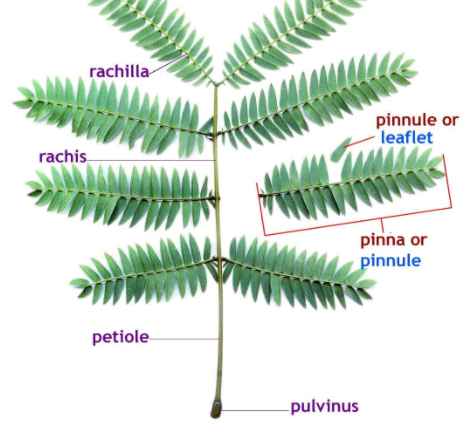
What is 'Pulvinus' in leaves? In which plants is it found? What are their functions?
Answer
412.8k+ views
Hint: A pulvinus is a joint-like thickening situated at the base of a plant leaf or a leaflet that facilitates growth-independent nyctinastic and thigmonastic movement. Pulvini can be present at the base or apex of the petiole or even where the leaflets of a compound leaf are inserted into the rachis.
Complete answer:
A pulvinus is also sometimes called a geniculum. Pulvinus is a swollen leaf base.This type of leaves is seen in legume plants. The swelling results due to change in the turgor pressure. Night closure movement of legume leaves shows this pulvinar movement.
The pulvinus protects the young axillary bud. They are autonomous organs, which perform induced movements also when they are detached from stem and leaf. All pulvini consist of thick-walled water conducting vascular tissue that are surrounded by thin-walled motor cells which can undergo visible swelling and shrinking. Pulvini-based leaf movements occur in many plants of the bean family, the fastest responses can be found in Mimosa pudica, and Desmodium gyrans. While most plants can move their leaves only up and down, lupines can move them in any direction.
The diagram below shows a plant with different parts including the Pulvinus.

Note: Using nuclear magnetic resonance, upward movement of water within the pulvinus joint in response to electrical stimulation can be observed in the pulvinus at the base of the petiole. Movement of water to the upper or lower part of the pulvinus can cause asymmetric swelling thereby causing the petiole to either droop or rise and contributes to the characteristic displacement of the petioles.
Complete answer:
A pulvinus is also sometimes called a geniculum. Pulvinus is a swollen leaf base.This type of leaves is seen in legume plants. The swelling results due to change in the turgor pressure. Night closure movement of legume leaves shows this pulvinar movement.
The pulvinus protects the young axillary bud. They are autonomous organs, which perform induced movements also when they are detached from stem and leaf. All pulvini consist of thick-walled water conducting vascular tissue that are surrounded by thin-walled motor cells which can undergo visible swelling and shrinking. Pulvini-based leaf movements occur in many plants of the bean family, the fastest responses can be found in Mimosa pudica, and Desmodium gyrans. While most plants can move their leaves only up and down, lupines can move them in any direction.
The diagram below shows a plant with different parts including the Pulvinus.

Note: Using nuclear magnetic resonance, upward movement of water within the pulvinus joint in response to electrical stimulation can be observed in the pulvinus at the base of the petiole. Movement of water to the upper or lower part of the pulvinus can cause asymmetric swelling thereby causing the petiole to either droop or rise and contributes to the characteristic displacement of the petioles.
Latest Vedantu courses for you
Grade 11 Science PCM | CBSE | SCHOOL | English
CBSE (2025-26)
School Full course for CBSE students
₹41,848 per year
Recently Updated Pages
Master Class 9 General Knowledge: Engaging Questions & Answers for Success

Master Class 9 English: Engaging Questions & Answers for Success

Master Class 9 Science: Engaging Questions & Answers for Success

Master Class 9 Social Science: Engaging Questions & Answers for Success

Master Class 9 Maths: Engaging Questions & Answers for Success

Class 9 Question and Answer - Your Ultimate Solutions Guide

Trending doubts
State and prove Bernoullis theorem class 11 physics CBSE

What are Quantum numbers Explain the quantum number class 11 chemistry CBSE

Who built the Grand Trunk Road AChandragupta Maurya class 11 social science CBSE

1 ton equals to A 100 kg B 1000 kg C 10 kg D 10000 class 11 physics CBSE

State the laws of reflection of light

One Metric ton is equal to kg A 10000 B 1000 C 100 class 11 physics CBSE




